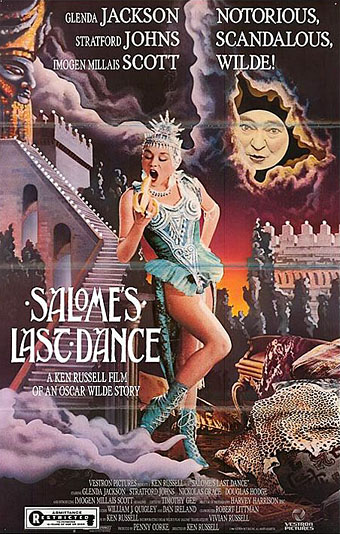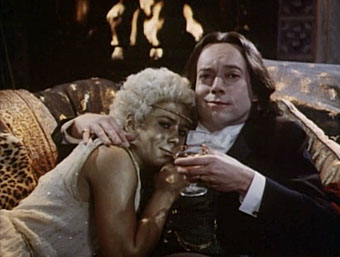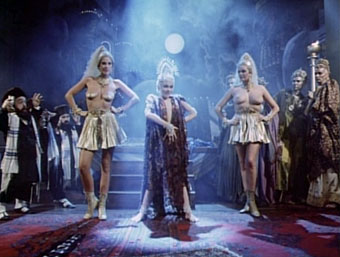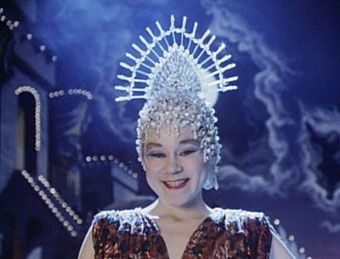
More Wildeana. It’s taken me over two decades to watch this film, and while I can’t really say it was worth the wait it was more entertaining than I expected. Salome’s Last Dance was directed in 1988 by Ken Russell and is his own typically mannered adaptation of the Wilde play. It appeared around the same time as his adaptation of another Victorian work, Bram Stoker’s The Lair of the White Worm, and it was the latter film which caused me to lose my patience with Russell’s excesses and so ignore this one. In Salome’s Last Dance we have Oscar Wilde and Lord Alfred Douglas visiting Alfred Taylor’s London brothel one night in 1892 where Taylor and company stage a performance of Wilde’s banned play.

Aubrey Beardsley’s illustrations appear in the title sequence.
If you’re a Wilde enthusiast there are at least two ways you may take this; you can be appalled by Russell’s “translation” of Wilde’s words (Salomé was written in French then translated for English publication in 1894; there’s no reason to re-translate a version the author approved), a translation which is really more of an adaptation, with much of the poetic monologue removed and the tone lowered for a general audience—Wilde’s “Iokannen” is vulgarised to “John the Baptist” throughout. Or you can try and enjoy what is at least a complete performance of the play, even though it more often resembles Carry On Salomé than anything one might have expected Sarah Bernhardt to perform. Injecting a Symbolist drama with slapstick and grotesquery is probably inevitable given the director (Russell is also co-writer and he plays—badly—the role of the Cappadocian). I found it impossible to decide whether Russell was sending up the play because he found it too pompous or whether he felt that an audience wouldn’t sit still for it otherwise. Whatever his intention, the premise is intriguing enough to inspire speculation as to how it might have been treated by other hands.

Oscar Wilde (Nickolas Grace) and friend.
Of the actors Stratford Johns as Taylor/Herod stands out for a delivery which goes beyond mere caricature and gives some life to the words. Glenda Jackson, in one of her last roles before she became an MP, seems to send herself up, while Imogen Millais-Scott as Salomé is a peculiar minx whose androgynous quality pays off during the Dance of the Seven Veils. Nickolas Grace’s performance is a vague sketch of Wilde, he doesn’t really look the part and Wilde’s character is reduced by the script to a succession of quips. Douglas Hodge as Lord Alfred/John the Baptist looks nothing at all like Wilde’s boyfriend; he’s too tall and his dark hair may be necessary for playing John the Baptist but the real Bosie was blond.

The Dance of the Seven Veils.
And yet… I still found the film enjoyable on the whole. Perhaps it’s because there’s a sense all the time of Wilde’s play struggling to break free; in some of the close shots and monologues you have a sense of the real power a decent performance might have. There are also resonances with other works if you care to look for them; Derek Jarman worked as set designer for Ken Russell on The Devils (1971) and Savage Messiah (1972) and later made his own film about a Christian martyr, Sebastiane (1976). The prologue of that film features Lindsay Kemp performing an obscene dance for the Emperor’s court, and it was Kemp who directed one of the notable Salomés of recent times. In his 1977 production at the Roundhouse, London, he took the title role and also stripped naked at the end, prefiguring Russell’s switch here. Nickolas Grace’s performance has its precursor in his role as stuttering invert Anthony Blanche for the TV adaptation of Brideshead Revisited (1981).

Imogen Millais-Scott.
Salome’s Last Dance is currently unavailable on DVD unless you want to pay a large amount of money for a secondhand copy. Lindsay Kemp’s queer-as-fuck adaptation was probably closest in contemporary terms to the scandalous power of the original but we don’t have a film of that, unfortunately. This leaves us with Stephen Berkoff’s acclaimed Royal National Theatre production which was filmed in 1992. Berkoff’s staging is available on DVD, and looks excellent. Another one for the shopping list.
Elsewhere on { feuilleton }
• The Salomé archive

One of my all-time favorites….I bought an Italian copy for very cheap about a year ago (like this http://www.daaveedee.com/product_info.php?products_id=107456&language=en), so it is easily available if you have a region free dvd player. I first became aware of the film via Elaine Showalter’s book Sexual Anarchy, which has some very interesting notes on Russell’s incorporation of a penis into Salome’s dance, etc.
Hi Amanda. I’ve read Sexual Anarchy, a great book and it was her discussion in that which made me realise I ought to give Russell’s film more of a chance. She also gives Lindsay Kemp’s adaptation a passing mention.
You’ve reminded me there was mention of an Italian DVD on the IMDB, good to know there’s copies around somewhere.
Imogen Millais-Scott’s performance is what I remember most about this film. She never manages to chip one tooth throughout the whole movie from all the scenery she seems to chew through. Sadly we have not seen more from her. As I remember she died too soon after her star began to rise.
Speaking of adaptations within adaptations and speculative Wildeana, would it be appropriate to mention Jon Macy’s “Teleny and Camille” is now published and available in a special edition at his web site?
Hi Nate. I mentioned the publication of Jon Macy’s book last month and he’s very kindly sent me a copy which I’m planning on reviewing shortly. I just re-read the novel in order to be able to compare the two.
IMDB doesn’t report that Imogen Millais-Scott is dead although she did have some health problems which would explain the truncated career. An NHS website has a page about her organ transplants.
Yes, I did catch your post. Silly me for belaboring the point. And forgive my faulty memory and hasty assumptions, but how wonderful to be proven so thoroughly wrong! I, for one, would love to see Ms. Millais-Scott on the big screen again. She reminds me of a young Giulietta Masina. How fortunate that we live in such a world of modern medicine. Thank you for the additional link.
John-it would seem a must see for anyone devoted to Wilde. I have recently read Vyvyan Holland’s memoir which was very insightful. On to Oscar’s letters.
Slow in returning to you the Cecil Beaton photographic info-
Gervase and Patrick Prockter posed in the drawing room, Reddish House 1969.
best, Gaye
Thanks for the Beaton info!
“Salome’s Last Dance” is an interesting bit of Wildean kitsch.
As I discovered quite recently, the film is available to watch for free on YouTube. It’s occasionally interrupted by adverts, but at least it’s a single file in decent resolution.
http://www.youtube.com/watch?v=9AFN3DydnxA
How the hell did I miss this post???
You know this is one of my all-time favorite films (Right up there with Cabaret)! I just watched it again recently and, while I can’t disagree with your thoughts on it, I love it more than ever. Yes, there’s the inevitable camp and kitsch of Ken Russell, but if one has a taste for that (and you know I do!) it’s quite refined in its own way. There are some true moments of cinematic beauty, an achievement of sorts for such a low-budget production. The performances of the three leads are the jewels in this decadent tiara.
I love Russel’s version, I think it’s often too readily dismissed as a pantomime but I actually think there’s great deal that can be said about it. I wrote an essay a while back about different versions of Salomé and I have to admit Russel’s is probably my favourite.
I particularly like the erstwhile femme-fatale being rendered as a petulant child with her love-heart lollipop juxtasuposing her bloodthirsty demands. Salomé’s characterisation throughout the film fascinates me.
Concerning the re-translation, Wilde hated Douglas’ interpretation into English and refused to officially credit him so I don’t think Russel should be too heavily critisized for giving it another go. I think there’s some evidence in the original French that Salomé was actually intended as a parody and Wilde never really categorized the play himself.
Anyway, nice post!
“Salome’s Last Dance” by Ken Russell (based on play by Oscar Wilde) depicts a predatory (possessive) personal love as a phenomenon typical for many people in all social strata in various historical epochs. By comparing the existential atmosphere in Ancient Judea under the Roman domination with the European modernity of the end of 19th century and the European post-WW2 democratic renaissance Russell creates a universal picture of predatory love in its social and psychological aspects. “Salome’s Last Dance” is a comparative analysis of amorous encounter between two human beings as a fight for domination when even sexual desire becomes the instrument in this fight and even dependent position in love relations is used as a leverage to tie up and control another person.
Russell makes Oscar Wilde a character inside his film, in order to, it seems, open an additional historical perspective, scholarly relativize Wilde’s play, and dramatize human personal encounter with historical forces. The director’s elaborate classification of the types of possessive love (all of them internalize and utilize the experience of social competitive fights as its pseudo-amorous code) that is quite applicable to our life in the 21st century is a serious achievement of this film.
Burlesque and tragedy mixed up on the screen, as it happens in life, defeating human imagination and moral idealism.
The acting is in the best tradition of English theater when actors not only articulate the characters’ emotions before the viewers but demonstrate their psychological roots. Glenda Jackson (Herodias and Lady Alice) and Stratford Johns (Herod and Alfred Taylor, the brothel keeper) gave in this film the sharpest performance of their long creative careers. Their mimic and intonational versatility is unique and memorable. Russell’s interesting analysis of the psychological peculiarities of homosexual love (based on love affair between Oscar Wilde and Lord Douglas/Bosie) is a part of his classification of types of personal love.
Please, visit: http://www.actingoutpolitics.com to read about Ken Russell’s film (with analysis of the stills from the film), and essays about the films by Godard, Resnais, Bergman, Bunuel, Kurosawa, Bresson, Pasolini, Antonioni, Fassbinder, Cavani, Alain Tanner, Bertolucci, Werner Herzog, Maurice Pialat, Jerzy Skolimowski, Wim Wenders, Rossellini, Moshe Mizrahi and Robert Neame.
By Victor Enyutin